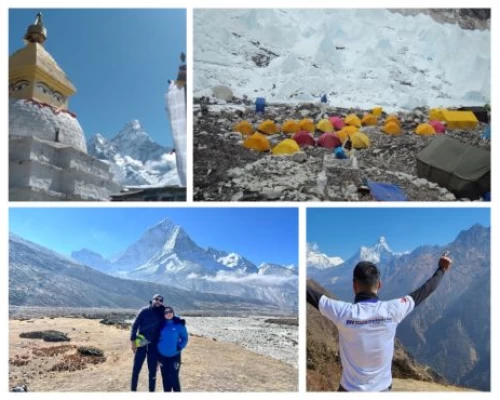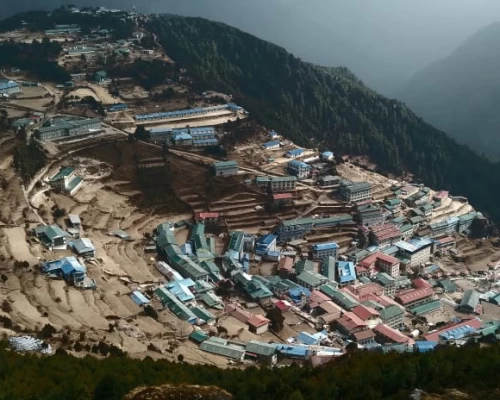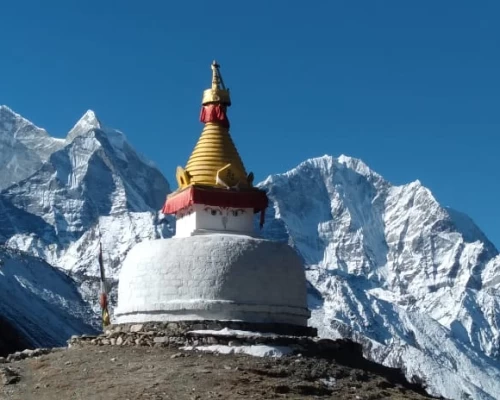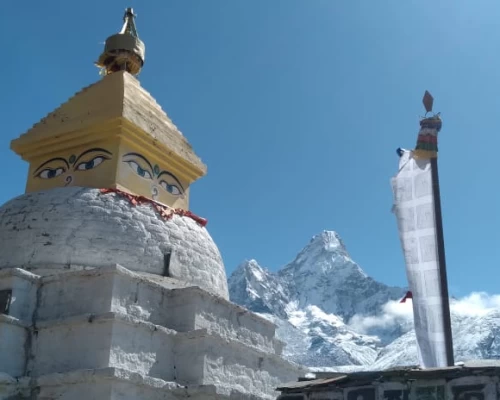While Travelling through Nepal, rumors swirl among the mountaineering community. This rumor is about a mythical peak dubbed "the Matterhorn of the Himalayas." Despite standing under 7,000 meters (23,000 feet), this imposing summit is renowned for its technical difficulty drawing climbers from all corners of the globe to brave its steep and unforgiving terrain. But it's not just the challenge that entices adventurers to its slopes. The allure lies in the raw, unspoiled beauty of the climb, with unparalleled exposure that takes your breath away. They call it Ama Dablam, or "mother's necklace." Those who dare to take on this life-altering ascent will be transformed forever.
The challenge of Ama Dablam calls. No matter if you're a seasoned all-round mountaineer or a first-timer. You just have to have a passion for the towering beauty of the Himalayas. If you've already explored Nepal's stunning landscapes and are seeking a new, more demanding ascent than Mera or Island Peak. This expedition is tailor-made for you. Or, if you're simply captivated by the sheer majesty and scale of the mountain and yearn to test your limits against it. Whatever your motivation, the chance to climb Ama Dablam awaits. The world's most skilled mountaineers have hiked beneath this precious jewel for half a century as they neared the towering Everest, Lhotse, and other majestic peaks of Nepal's Khumbu Region. Its elegant contours of rock, ice, and sharply fluted snow have beckoned to them all. While four of the planet's six highest mountains encircle this magical valley, Ama Dablam embodies the essence of a climber's aspirations: The sight of this stunning summit is recognized worldwide among mountain enthusiasts. The landscape of Ama Dablam is genuinely magnificent. And despite its intimidating appearance from a distance, it is consistently less challenging than one might expect. However, it's crucial to possess a strong tolerance for heights and comfort with exposure, as coming unprepared could result in a dangerous and unforgettable setback.
Standing at 6,812 meters (22,349 feet), Ama Dablam may not be the highest peak in the Himalayas. But it is undoubtedly a sight to behold and holds an iconic status. Known as the "Matterhorn of the Himalayas," the mountain's stunning profile dominates the skyline between Tengboche and Dingboche. This leaves a lasting impression on trekkers who have been to Everest Base Camp. As Nepal's third most popular expedition peak, climbers usually take the southwest ridge and establish three intermediate camps on their way to the summit. Mike Gill, Barry Bishop, Mike Ward, and Wally Romanes achieved the first successful summit in 1961. However, the mountain has seen its share of tragedies. One such tragedy includes the 2006 avalanche that killed six climbers at Annapurna's Camp 3. In 2008, a chunk of the hanging glacier, part of the namesake "Dablam," broke off, causing some climbers to skip Camp 3 and attempt the summit in one long day from Camp 2.
Ama Dablam is a true gem of the Himalayas that has captivated the imaginations of alpine climbers for generations. Its location directly above Tengboche Monastery on the popular path to Everest Base Camp makes it an ideal choice for the team's ascent. The traditional South West Ridge, renowned as one of the world's most aesthetically pleasing climbing routes, would be their chosen path. The climb would start at camp one, navigating through intricate rock towers, before reaching the infamous and perilously positioned camp two with its breathtaking exposure. Finally, the team would ascend the upper icefields to the summit. They would be rewarded with a stunning panoramic view of the Everest Massif, including neighboring peaks like Lhotse and Makalu - if the weather favored them.
What to Expect
For many climbers, the allure of scaling the heights of Ama Dablam in the Himalayas is a dream. It calls them to undertake the expedition. It represents a challenge they are determined to overcome. This helps them prove to themselves and the world that they can reach the summit. This is undoubtedly the primary motivation for most. Likewise, the region's cultural heritage and stunning natural beauty are one of the compelling reasons.
Although reaching camps II and III and, ultimately, the pinnacle is no easy feat, the journey to the base camp is a delightful experience. The forests that clothe the hillsides present a stunning array of changing colors. Also, the opportunity to encounter farm and wild animals and birds is unforgettable. Friendly Sherpa-run lodges and tea houses offer a warm welcome. This adds to the richness of the experience. Despite the challenges, the breathtaking views of the snow-capped mountains surrounding Ama Dablam make this expedition a truly worthwhile endeavor.
Ama Dablam (22,501 ft) is not just a mountain to climb for its beauty but also for the rich cultural experience you will encounter. You will get this experience as you pass through remote villages such as Namche Bazaar, Khunde, Deboche, and Pangboche. This allows you to immerse yourself in the unique Sherpa culture. The technical terrain on the mountain's upper slopes will challenge your mountaineering skills. These challenges will make this expedition more remarkable. The climb up Ama Dablam strikes a delicate balance between risk, effort, and reward. This climbing will take your climbing abilities to new heights while providing unparalleled views of the Himalayas.
The base camp is at 4,500m, nestled in a lush green meadow. This place was traditionally used as the grazing ground for yaks herded by the Khumjung village. Moving upwards, at 5,200m, we reach the Advanced Base Camp (ABC). From here, we must establish two more camps before embarking on the final leg of our journey to the summit. To reach Camp I, situated at an altitude of 5,815m, we must tread with caution over exposed rock sections, including the challenging 'Yellow Tower,' and push ourselves further to reach Camp II, which is situated at around 6,000m. This miniature camp is perched on an exposed ridge and can barely accommodate 2-3 tents. The ascent from Camp II to Camp III at 6,400m involves navigating treacherous ice gullies, a corniced ridge, and an ice wall, requiring expert alpine rock-climbing skills. From Camp III, an immaculate 50-degree snow and ice slope beckons us to the summit of Amadablam, making it mandatory for the climbers to be adept in alpine ice-climbing techniques and have experience in scaling mixed terrains while carrying a backpack.
It will be Colder Than You Think:-
At 22,000ft snowy peak beckons adventurers to brave the biting cold of its summit. While seasonal fluctuations in temperature may vary, the frigid nights and the potential for a bitterly cold summit day cannot be ignored. To prepare for this, one must be able to tackle any weather condition. Be it snow or shine, endure long, arduous days on the hill across various seasons. This serves as one of the best training for expeditions of any kind. Previous trekking experiences are beneficial. But not everyone has the time and money to venture on such trips. However, your circulation may be impacted as you climb higher and oxygen levels decrease. This causes you to feel even colder. To overcome this, you must bring high-quality clothing and equipment. Be familiar with, keep a good stock of hand and foot warmers, wear loose-fitting boots, and stay hydrated. Instinctively layering up when required, staying active, and avoiding exposing your hands to the cold is the knowledge that comes with years of experience on the hills.
It Will Be Harder:-
Without prior experience, it isn't easy to anticipate the challenges of climbing. Cultivating a strong climbing and mountaineering resume is necessary. With this, you can prepare yourself better for the unexpected twists and turns that may arise. On Ama Dablam, you can expect a mixture of climbs. There will be climbing difficulty, grade 3 terrain, and alpine-style terrain at an altitude of 6,000m. Adaptability to changing mountain conditions is crucial, especially since you'll exert yourself for several days. Success in reaching the summit depends on navigating the vertical environment and caring for yourself in shifting conditions. If you acclimate well at Camp 1, you're likely to fare similarly at Camp 2, which is only slightly higher, and subsequently at Camp 3. With the determination, stamina, mental fortitude, and positive attitude that come with experience, you can push through and achieve the summit despite potential weather and illness obstacles. This requires digging deep, but with persistence, you'll develop the skills to overcome even the toughest challenges.
It will be slow going at altitude:-
Yes, you will ascend very slowly. You may see many trekkers who think they may be moving slowly, and you may even find yourself urging them to slow down further. It's reminiscent of the tortoise and the hare fable. Trekkers who charge ahead usually stop every 10 to 15 minutes, whereas those moving more leisurely will catch up and glide past easily. Perseverance and self-management are key on this journey. Simple tasks like adjusting zippers, hats, gloves, applying lip salve, or taking sips of water can all be done while moving. Together completing these tasks during stops can also save precious time. It's also crucial to prioritize self-care upon arriving at the next camp. Remember that staying hydrated is more important than eating. And eating is more important than sleeping. While on the mountain for several days, depleting your resources is easy. So rest, rehydrate, and recover once you return to base camp before your next excursion.
May not Get Enough Sleep:-
Sleep apnoea, specifically Cheyne-Stokes breathing, can be challenging for some individuals. This will occur when going to high altitudes due to pH imbalances in the blood and how the brain regulates breathing during sleep. This condition involves moments of not breathing, followed by a sudden gasp for air when the body has the appropriate level of CO2. This can be unsettling. But it is common on high-altitude trips and is experienced by most people. This is a normal bodily response, and take comfort that you were likely experiencing it at base camp before acclimating. Despite feeling like you haven't slept, it's likely that you've gotten some quality rest during your 12-hour sleep.
Routes of Climbing
The summit of Ama Dablam can be reached through eight distinctive routes. Still, the Southwest Ridge Route is predominantly utilized by guides to escort climbers to the top. Whereas the remaining routes are primarily opted for by skilled mountaineers only. We also go to the Ama Dablam through Southwest Ridge Route, ignoring the other seven routes.
Ama Dablam Through Southwest Ridge Route:-
Your journey to the summit will begin from Kathmandu with a flight to Lukla (2840m). You will cross Phakding (2610m) and Namche Bazaar (3440m) from there. You will take a day to acclimate before pushing towards even greater altitudes. Your journey continues to Tengboche (3860m) and Pangboche (3900 m). From Pangboche, your journey begins with a climb to the awe-inspiring Ama Dablam Base Camp (4600m). Upon reaching the Ama Dablam base camp, take a few days to acclimate yourself while the Sherpa team and guides start preparations, such as fixing the route and setting up camps along the SW Ridge. This approach will facilitate a smoother adjustment to the new environment and altitudes, ensuring the team can advance gradually and safely. The Southwest Ridge Route, first ascended in 1961 by a team of U.S. and New Zealand climbers, remains the most popular way to climb the mountain. This challenging route offers breathtaking views at every step and is the preferred choice for most expeditions.
The climb is divided into several sections. This starts with a hike from Base Camp to Camp I, just over 1,000 meters in elevation. Following a suitable break, embark on a journey towards camp one carrying only essential supplies such as water, food, and a camera. While not particularly strenuous, the day's ascent will be a skill test for all team members. As we begin our Ama Dablam acclimatization, the thin air at altitudes exceeding 5600 meters will undoubtedly have a noticeable impact on us. From Camp I, you will tackle the technical portion of the climb, which includes a two to five-hour ascent from Camp I to Camp II. You will get enough acclimatization days. This section involves climbing over granite blocks and heading to the Yellow Tower. The most challenging part of the climb is from Camp II to Camp III. TThs because you need to hike for around three to six hours to reach Base Camp III. This section starts with an exposed ridge traverse to the Grey Tower, followed by a loose but short multi-pitch climb. The airy traverse leads to Mushroom Ridge and a thin ridge walk. Camp III sits at 6,277 meters, and the final push to the summit takes another four to six hours. This mixed climbing will reward you for your hard work, and you'll enjoy the incredible views once you reach the summit without any false summits to worry about.
The burden of carrying the ropes, hardware, and camping equipment for the high camps will rest solely on the Sherpa team's shoulders. To conserve energy and prevent altitude-related complications, the team leaders and members plan to spend at least two nights at camp one and one at camp two before gradually returning to base camp or Pangboche for a much-needed rest. Meanwhile, the Sherpa team will diligently prepare and stock all the high camps for the final ascent, ensuring the climbing route is safe and accessible for the entire team.
Alternative Routes:-
Although there are eight Ama Dablam climbing routes, the Southwest Ridge Route is the most commonly used by guides leading climbers to the top. The other routes are typically reserved for experienced mountaineers. Some of the alternative routes include:
Lower Route: Successfully climbed for the first time in April 1979, following the Southwest Ridge Route.
North Ridge Route: Became one of the main alternatives to the Southwest Ridge Route after its first ascent in October 1979.
East Ridge Route: Considered more challenging, this route was only successfully climbed after 1983.
Northeast Route: The steepest route and the site of the first winter climb of Ama Dablam in 1985.
Ariake-Sakashita Route: On the west face of the mountain.
Stane Belakrauf Memorial Route: First climbed by Vanja Furlan and Toma Humar in 1996 on the northwest face of the mountain.
Northwestern Ridge Route: This route has only been successfully climbed to the top once, in 2001.
How Can I Prepare For Summit Ama Dablam?
Ascending Ama Dablam demands a solid background in high-altitude mountaineering and alpine-style climbing. You will also need expertise in scrambling, traversing, and navigating steep rocky or icy terrain. The ability to use fixed-line ropes and climbing gear safely is also essential. Furthermore, one must be acclimated to and comfortable with cold conditions. Prior experience climbing peaks of 6000 meters or higher is strongly recommended to ensure adequate preparation for this expedition. Ama Dablam poses unique challenges and potential hazards. This makes it essential for individuals to be thoroughly prepared and confident in their abilities.
Requirements for Climbing Ama Dablam:-
For Absolute Beginner:- Suppose you are a complete beginner with no experience in high-altitude trekking. But have an equally burning desire for mountaineers to climb the Ama Dablam someday. If this is your condition, we can begin your journey. Join our Mountain Rock Team and participate in our introductory expeditions to Yala Peak (5032M) and Mera Peak (6476M). These peaks will serve as your first foray into mountaineering. It allows you to test and challenge yourself with high-altitude trekking or non-technical peak-climbing adventures in Nepal or beyond. You must be in good physical condition for these expeditions too. These expeditions will teach you the basics of mountaineering. This will boost your confidence to tackle higher and more technical peaks.
Beginner - Intermediate Level:- At this level, you should have some knowledge of mountain climbing. Also, you should understand the level of fitness and mental preparation required for expeditions. In the next training phase, you will develop your skills to climb at high altitudes, including some technical pitch sections ranging from beginner to intermediate level. Additionally, you will build upon your basic climbing abilities and learn more advanced specialized climbing techniques. This will include navigating mixed rocky, snow, and ice sections, scrambling and traversing on exposed areas, and jumaring on a fixed-line rope to tackle vertical sections of the mountains. These skills are critical for your progression as a mountaineer. Completing expeditions of this type will give you the confidence to take on even tougher and more technically challenging peaks in the Himalayas or worldwide. We highly recommend expeditions such as Lobuche East and Island Peak for climbers at this stage. These expeditions offer all the technical and physical challenges necessary for climbers looking to progress at the intermediate or higher level.
What Fitness Level is Required:-
A unique set of skills and abilities is required for an expedition like Ama Dablam. You must possess an exceptional overall fitness level. This fitness level should encompass acclimatizing to high-altitude environments, endurance, strength, and mental toughness. One should also develop resilience to withstand extreme weather conditions for extended periods. Carrying a load of 8-12kgs over multiple days can also be physically demanding. Given the nature of this expedition, previous experience in high-altitude climbing is highly recommended. This helps to prepare for the demands of altitude and terrain. Preparing for the unique conditions of Ama Dablam requires significant dedication and effort. Achieving the required fitness level involves striving for high endurance and strength levels. As a general indication of the fitness level required, individuals should be capable of running a half marathon to a marathon distance or cycling for 5-6 hours. For those who prefer hiking, carrying a load of 25 to 30 kilograms and hiking for six hours or more is a good benchmark.
Additionally, implementing a good strength and muscle endurance training routine is crucial. This can be achieved through various approaches, including participating in CrossFit sessions and kettlebell training. However, this training should be done under the guidance of a professional trainer or coach.
Skills That Should be Learned:-
When visiting Nepal, expert guides recommend keeping things simple. However, there are four essential skills you must learn.
- First, learn to tie a Figure 8 and stopper knot to secure the rope's end.
- Secondly, practice ascending on a fixed line and abseiling with a Super 8 belay device or ATC descender for multi-pitch climbs. Abseiling requires extreme caution since mistakes are not an option. Tying a 'prusik knot' on the main rope is wise as a safety backup.
- Thirdly, master climbing, scrambling, and traversing while wearing crampons on snow, ice, or rock surfaces for extended periods.
- Fourthly, develop the ability to perform a snow arrest and safely regain control if sliding or slipping. Additionally, it is vital to have experience in ice climbing, specifically WI-3 to WI-4, for the Spring Ama Dablam expedition. Whether indoors or outdoors, the Alpine grading scale may serve as a reference for multi-pitch rock climbing up to grade 5-9+/- to 5.10 a,b,c.









